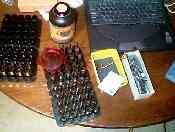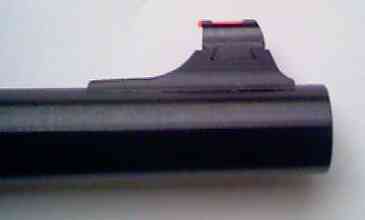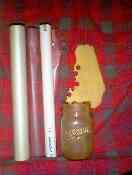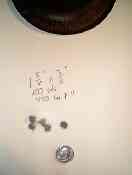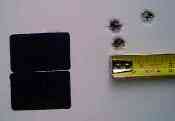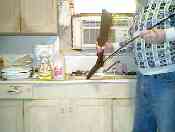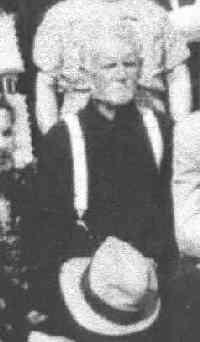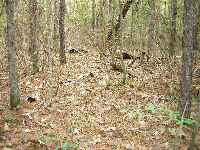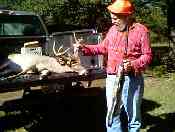by Junior Doughty
|
I try to visit my local gun shop at least once a week. It's the Blade ‘N' Barrel Gun & Pawn in Jena, Louisiana. I like to look over the new arrivals, new and used, and I like to shoot the bull with the other gun nuts who also visit at least once a week. On a visit in June, 2002, I spied something interesting on the wall-mounted gun rack in the rear of the store. It looked like a break-open single-barrel shotgun but different somehow, sturdier, and with rifle sights and a short barrel. I raised it to my shoulder, and it came up easily, pointed naturally. I liked the way it felt. As my glasses dangled from around my neck instead of perched on my nose, I couldn't read the stamped letters on the rifle or the tag hanging from its trigger guard. "Hey, Carl," I spoke to the owner, "what is this thing?" "It's a Handi-Rifle," he answered. "They're good rifles." I put my glasses on my nose and read the stamped letters. First thing I saw was: CAL. 45-70 GOVT Next thing I saw was the hanging tag: $249 "Is it used?" I asked. "Nope. Brand spankin' new," he answered. With its short barrel and large caliber, I held in my hands the ideal woods rifle for deer, I believed, especially with pure lead bullets and black powder. For several years I had followed closely the black powder cartridge rifle articles by Mike Venturino in Shooting Times magazine. The black powder cartridge rifle bug had bitten me, and the itch was greater with every issue of the magazine. So there I stood, holding in my hands not just a good woods rifle but a black powder cartridge rifle—at 1/4 the cost of others I had priced. But, in my normal financially embarrassed state, I didn't have $249.00. Besides, I would need to buy 45-70 brass, pure lead, bullet molds, and reloading dies. Heck, all that could cost as much as the rifle. So I put the rifle on lay-a-way. From the local salvage yard, I purchased 30 lbs of pure lead at 33¢ per lb = $10.00. From MidSouth Shooters Supply, I ordered 100 empty Remington 45-70 cases, reloading dies, a special neck die, a special crimp die, a Lyman mold, two Lee molds, a padded gun case, a sling, shell holders, case length gauge for my Lee trimmer, boxes for loaded rounds, etc., etc., = $279.11. Total so far = $289.11. In case I got a chance to play Billy Dixon and camp and cast and load in the woods again, from the Lee Precision web site I ordered a #90264 45-70 Lee Loader @ $19.98 + Lee's little #90040 special order 45-70 Flaring Tool @ $4.00 + shipping = $25.98. Total now = $315.09 for supplies and the rifle cost $249.00. When the loading goodies arrived and while I slowly paid on the rifle, I cast a bunch of bullets, noting that big bullets used lots of lead. My 30 lb hoard didn't last long. My bullet molds were:
On each visit to the gun shop to make a payment, I'd marvel again at the little rifle with the big bore. But although I liked the rifle, I didn't like the factory sights. I also had a sneaking suspicion they wouldn't work at black powder/big lead bullet velocities. I made a call to Williams Gunsight Company @ 1-800-530-9028 On the advice of a man in customer service, I ordered:
Total for supplies and extras now = $421.49 and the $249.00 rifle was still in the gun shop. (Perhaps your wife shouldn't read this, huh?) But the little rifle with the big bore finally came home with me. I loaded a couple of rounds with Pyrodex RS to experiment with charge level and bullet seating depth. As per Mike Venturino's
My rifle had almost no throat, maybe .050", so I seated all bullets with the case mouth about 1/2 way up the forward driving band of the bullet. With the case mouth in the crimping groove of each bullet, the case had to be chambered with mild thumb pressure, forcing the leading edge of the forward driving band into the lands. The ejector, then, would not eject an un-fired round. Ok for target shooting but not for hunting. Here's the OAL of a loaded round with each bullet seated so the forward driving band just touches the lands of my rifle:
I measure black powder/Pyrodex with Lee dippers. A 4.6 cc load, for example, uses the Lee 4.3 cc and .3 cc dippers. To prevent double charges with the .3 cc dipper, charge the empty cases with it first, visually checking each case, then charging with the 4.3 cc dipper. To settle powder in the cases simply drum your fingers on the sides of the plastic loading block. The cases and powder vibrate, packing the grains of powder. Bullets loaded, the shooting began. I may be broke, but some things are better than money. For example, my benchrest is on my front porch, and my shooting range is in my front yard. It has target boards at 50, 100, and 150 yards. I can load three rounds and step out on my porch and shoot them. That's what I did, immediately noting two important facts:
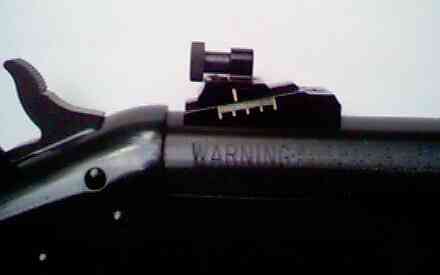 I easily removed the factory sights. I then installed the Williams sights. The rear WGRS sight attached without difficulty via holes drilled and tapped for scope mounts in the receiver.
I easily removed the factory sights. I then installed the Williams sights. The rear WGRS sight attached without difficulty via holes drilled and tapped for scope mounts in the receiver. The front sight, however, was a problem. The Shorty Ramp came with an attachment screw larger than the hole drilled and tapped in the barrel. It was also made for a .625" diameter barrel. The Handi-Rifle barrel measured .822" at the ramp position, so the ramp sat on its edges atop the barrel, a slight space beneath its center. But, luckily, the head of the smaller screw which had held the factory front sight on the barrel caught the edge of the too-big hole through the Shorty Ramp. It would hold, I decided, with a little help from J & B Weld.
If you will notice the top photo and the adjustment of the WGRS rear sight, the man at Williams customer service knew his stuff on the height of the front sights I needed. The rifle is zeroed at 100 yards for Pyrodex and the big Lyman 480 SP, and I still have up and down adjustment. Installing the WGRS rear sight increased the rifle's sight radius from 14 3/4" to 21", a 42% increase. Such a large increase in sight radius should create a corresponding increase in the rifle's potential accuracy.
My rifle didn't like the Lee 405 FP. In 5 shots, 3 might hit the paper at 50 yards. The Lee 450 FP and the Lyman 480 SP shot much better, but they still shot poorly in my opinion—3" to 4" 3 shot groups at 50 yards. The special neck and crimping dies didn't help. I started thinking my $249 rifle wasn't such a bargain. I gave up in disgust. Damned if it didn't look like I would—horrors!—have to shoot jacketed or hard cast bullets and smokeless powder. Then I started searching the Internet. The original Sharps Rifle Company, I discovered, recommended the use in their rifles of a 1:2 ratio beeswax:sperm oil cookie beneath the bullet. Well, there's no sperm oil in North Louisiana, I told myself, but there's plenty of hog lard.
I gave up on the 405 FP. Then I tried the $19.98 Lee Loader on the other two. Both bullets preferred the whack-it-with-a-hammer Lee Loader over the much more expensive dies. That included the Lee 450 FP whose flat point was deformed by the spire point-cavitated Lee Loader seater punch.
The Williams Firesight front sight covers a 12" circle at 100 yards. The quarter marks the center of the aiming point. I sat the black target on top of the Firesight. Imagine the group if shot with a scope and perfect bullets.
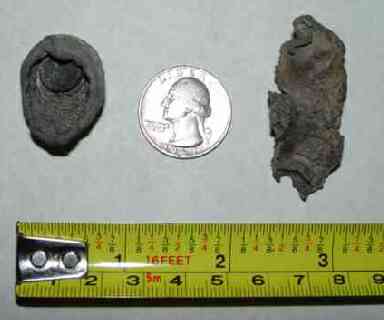 Shown actual size and with a quarter and a rule for scale, here's two of those big ol' 501 gr bullets recovered from behind targets. The one on the left I dug from a dirt bank at exactly 210 yards. It weighs 493 grs, a weight retention of 98 %. Of more importance, it mushroomed to a diameter of 7/8" x 1 1/8".
Shown actual size and with a quarter and a rule for scale, here's two of those big ol' 501 gr bullets recovered from behind targets. The one on the left I dug from a dirt bank at exactly 210 yards. It weighs 493 grs, a weight retention of 98 %. Of more importance, it mushroomed to a diameter of 7/8" x 1 1/8". The bullet on the right hit a gravel road at 50 yards and bounced into a dirt bank. It weighs 459 grs, a weight retention of 91 %. It became a buzz saw-like projectile 3/4" wide and 1 7/8" long. Imagine either of those bullets whizzing through flesh. When I saw those two recovered bullets, I had no doubt of the killing power of my Handi-Rifle and pure lead/black powder load combination. A deer hit from any angle, even the rear, would go down and stay down. I liked the Lee Loader. However, I didn't like its priming process, so I used my hand-held Lee Auto-Prime. With the Lee Loader I could load at my kitchen table. I rested the butt of the loader on a small board placed in a chair, and I whacked the loader with a wooden hammer handle. The seater seated the bullet with crimp or with no crimp. No crimp worked best in my single shot rifle. The neck size die sized just a small section of the case. The $4 thimble-size flaring tool belled just the case mouth, not even touching the rest of the case neck. I simply pushed the little tool into the case mouth, wiggled it, twisted it, and the mouth was belled. I especially liked the de-prime process. It was easy to de-prime just two or three cases. I liked the Lee Loader so much I ordered another one—that gave me a loader for the Lyman 480 SP and a loader for the Lee 450 FP. No more readjusting seating depth for a different bullet. I put a daub of epoxy in the spire point cavity of the new loader's seater, oiled the nose of a loaded 450 FP round, and eased the upside down seater into the die and onto the nose of the loaded round. Next day, it popped right out. The cavity perfectly matched the nose of the 450 FP.
I'm looking closely at the Lyman #457132 535 gr Postell mold. If I buy it, the bullet will have—you guessed it!—its own Lee Loader, flaring tool, and primer pocket cleaner. As I was out of lead, another trip to the salvage yard garnered me 370 lbs. Hey, I liked this black powder cartridge rifle shooting! Total = $122.10. The grand and final total for supplies and extras for a $249.00 rifle now = $572.55. (It's a good thing I'm not married, huh?) The velocity data in the table below came from chronograph screens placed 10 feet from the rifle's muzzle. (The cookie interfered with readings taken with the screens 6 feet from the muzzle.) The Lee 405 FP data came from a few 3 shot groups. The Lee 450 FP and Lyman 480 SP data came from many 3 and 5 shot groups. Except for the 405 FP, all rounds loaded with a Lee Loader and with no crimp. All bullets lubed with and noses finger-wiped with Junior Lube. Cases = Remington. Primers = CCI 200. Powder = Pyrodex RS.
There's a trick to getting great accuracy with cast bullets. With a black felt-tip pen, I mark each Lyman 480 SP bullet directly opposite the easily-visible sprue wipe. I scratched the nose section inside a mold half of the Lee 450 FP. I then mark each bullet on that barely-visible scratch. I put a black mark on the base of each case at its edge. For my Remington cases, I put the mark in the space between the R and the P. When loading, I align the black marks on the bullets with the black marks on the cases. When chambering the loaded round, I orientate up the black mark on the base of the case. Each fired bullet exits the rifle's muzzle in almost exactly the same position relative to the way it exited the bullet mold. Here's a couple of pointers on shooting good groups from a fellow who's been shooting them for 40 years—me:
The bore and chamber clean, move to the other side of the sink. Turn on the hot tap water, catch it in a cup or a glass, and, chamber end up, pour the hot water through the bore and over the barrel until you rinse out and off all the soap. Wipe the barrel's surface with a dry rag, and then run a dry swab or patch through the barrel, then run another dry one through it for insurance. The barrel 99% dry inside and outside, leave the action open and lean the rifle in a corner for at least 30 minutes. Warm air inside the warm barrel will rise, taking any left over moisture with it. The barrel totally dry, oil the surface with petroleum based oil and oil the bore with sodium free (salt free) vegetable oil such as Crisco. If you plan to store the rifle, oil the bore with petroleum based oil but remove every trace of petroleum based oil from the bore before firing a black powder or Pyrodex round through it. Black powder + petroleum based oil = tar.
The cases inside the jug clean to my satisfaction, I dump the soapy water, then stick the jug under the hot water tap until all the soap bubbles are gone. Then I let the cases air dry. Nothing to it. On this "Cleaning The Cases" step, the Lee Loader de-primer shows its stuff. For one thing, the de-primer doesn't do anything else to the case—it just de-primes. For another thing, the black powder fouling inside the cases gets only on the de-priming rod. When you're done de-priming, rinse the fouling off the rod, dry it, then oil it. If you forget, you'll know it next time by the rust on the rod.
I've never been a permanent stand hunter. Shooting deer at 400 yards from a penthouse isn't for me. I carry a fold-up three legged stool from a clip on my belt, and when I make a stand I unfold the stool and put it in a briar patch or a downed tree top and sit on it. What I really like to do is ease along at a snail's pace, covering perhaps 100 yards in an hour while stopping for an occasional long and leisurely lean against a tree. I do my best communing with Nature while leaned against a tree or sitting on my three legged stool. A frosty morning during deer season, 2002, found me sitting on my stool at dawn. I was in woods a few feet from a little meandering creek and perhaps 200 yards from my house. (As I said earlier, there's things better than money.) My back against an oak, I faced the rising sun peeking through the trees beyond the creek. Close in front of me, two saplings served to break up my silhouette and as rifle rests. I love morning in woods. In spring, dawn starts in silence and quickly becomes a cacophony of tiny musical voices, birds singing their joy of the new day. I visualize myself in the clouds and watching the bright curtain of day mutely crawling across the dark land, followed by a wave of musical sound. But in winter, dawn seems profound in its silence. The day comes without noise, without motion. Only cold. As I sat and watched and listened and shivered, the air across the creek hung hazy in the beam of the rising sun. In the dark naked trees the wispy air seemed so thick with moisture you could live without drinking, just breathing. Then the sun rose higher, bringing the coldest part of the dawn and the day. Warmth rose gently from the heated tops of gray oaks and green pines, creating an imperceptible and rising current of air on the floor of the forest below. Slowly the layer of warmth around my body dissipated. I leaned over, huddling my body against itself, against the cold. I watched the melted frost in the tree tops above me float like misty falling rain down through the thick, sunbeam illuminated air in front of me. Large drops fell in little spurts, gleaming in the sunlight like falling glass rods, going splat . . . splat . . . on me and on the dead leaves covering the ground around me. And something moved. The motion came from far to my left. I slowly turned my head, the cold and the frost rain forgotten, my eyes searching. Finally, I saw an animal basking in a patch of sunlit ground some 75 yards up the creek and on the other side. A slight rise blocked my view of its lower body, but I could see the horizontal ridge of its back and its vertical neck, its face up and toward the sun. I eased the Handi-Rifle from across my legs to a semi-firing position against the side of a sapling in front of me. But the animal had no horns, a doe, illegal game that day. But her head looked strange. I eased the rifle back across my legs and slowly raised my binoculars to my eyes. It was a . . . a dog? A white dog? As I watched, it got to its feet, and I could see its tail—a coyote. A white coyote? It trotted out of sight in a brushy thicket along the creek. I lowered the binoculars. My eyes still looking across and up the creek, suddenly there was the coyote again. It trotted along the other side of the creek and much closer to me. It was grayish-white but with dark eyes, not an albino. Perhaps old? It was fat and fine, probably on a diet of deer gut-piles . . . and an occasional cat, I remembered. I thought of shooting it. But it had lived in those woods for many years. What's a missing cat now and then? No more than 20 feet from me, it jumped down in the creek bed and out of sight below the bank. Getting a drink of water. I wondered why it didn't smell me. Maybe the rising air current? I knew why it didn't see me—I was camo from head to toe except for a hunter orange vest. My eyes looked through a slit in a camo face mask. Then, it jumped out of the creek bed and back on the bank. As I watched, it trotted up the rise on the other side of the creek and disappeared in a thicket. I was alone again in the silence and the cold. Soon, a beam of sunlight found me. I basked in the warmth for several long minutes, finally nodding my head sleepily. Realization came that I was spotlighted like the coyote. Time to move. Getting to my feet, I folded the stool, clipped it to my belt, and started slowly walking along the edge of the thicket beside the creek. A few yards later I reached what I believe to be the old buffalo crossing of the creek. It was a straight-as-an-arrow wedge-shaped gully perpendicular to the creek. Wider at the creek, it tapered inward and upward some 50 yards up the side of the gentle hill until it merged with the side of the hill. Obviously to me, the hooves of buffalo and later the hooves of horses created the ramp-like crossing. I stood on the Natchez Trace/El Camino Real, the ancient 1,300 mile long road from Natchez, Mississippi, to Mexico City, Mexico, which traverses the 125 acres of Doughty land upon which I live . . . and hunt.
I eased across the buffalo gully. I came to a spot with a narrow but maybe 70 yard view in front of me and down the creek. A wide and maybe 50 yard view was to my left and across the creek. About 20 yards to my right lay the rusty and mangled ruins of Fort Doughty. My baby brother, David, and his buddies built it in the 60s of scrap 2 x 4s and battered second-hand corrugated roofing tin. It rotted down, then a skidder ran over it in the 70s. All that remained was twisted, half buried rusty brown metal. The thought struck me that David, a crack shot from the time he could hold up a rifle, surely knew about crack shot and buffalo hunter Billy Dixon. If David and his buddies played cowboys and Indians, surely David was Billy Dixon. Little did he know that Billy Dixon probably trod the ground upon which the fort was built. After all, it stood beside what was once the major east/west road across the southern United States.
The morning was warmer, the mist gone, the frost rain over. I decided to unfold my little stool and sit a while in the shadows beneath the pine on which I leaned. I propped the Handi-Rifle beside me on the pine, and, soon, down I sat. But the pine grew out of a little hump, so my stool sat at an angle. I kept sliding forward. Well, hell, this ain't workin', I told myself. Maybe I can lean back. I dug in my heels and pushed backwards, leaning against the pine and with the stool on two legs. I could stay there as long as I kept my heels dug in. But, Hell, I told myself, suppose a deer walks out and me in an awkward position like this? And out walked a deer. It was about 40 yards away and in the bushes on the other side of the creek and walking in my general direction. After my heart started again, I eased my left hand back and felt the rough bark of the pine, then moved my hand around until I found the rifle. Slowly, ever so slowly I brought the rifle around while the deer stopped and looked over its shoulder. A doe, I could then tell. There might be a buck behind her. She easily jumped the creek and walked even closer—20 yards . . .15 yards . . . 10 yards. I dared not move from my uncomfortable position. I scarcely dared to breath. My legs ached. She walked to my right and between me and the ruins of Fort Doughty. Now no more than 20 feet away, she stopped and munched on the few remaining leaves on a bush. And she looked over her shoulder again, her mouth chewing, moving back and forth. I looked, too. There sticking above the bushes on the other side of the creek and coming toward me was a set of deer horns, shining in the sun. Ever ever so slowly I raised the rifle to my shoulder and aimed. I couldn't see the front sight! No matter how I tried, I could not find that big red LED-like Firesight! What to do! What to do! By now, the buck—a big one!—had reached the creek. His head down like deciding whether to wade or leap, he leaped the creek and landed on my side and about 30 yards from me. As I frantically hunted my front sight, he casually walked behind a grove of pine saplings and stopped. So I pointed the rifle like a shotgun at what I hoped was deer and not a sapling and pulled the trigger. As the boom died, I heard the doe crashing away through brush on my right. As the cloud of smoke in front of me dissipated, I saw the buck running away seemingly unhurt, then leaping to his and my left and over the creek and out of sight in the brush on the other side. My heart fell. As I quickly opened the Handi-Rifle's action and ejected the empty case and inserted a loaded round, I let the stool and myself fall forward, relieving my awkward position. The buck was gone. I looked down at the rifle, trying to determine the sighting problem. It was evident. The .150" hunting aperture was in the peep sight of my muzzleloader which was leaning behind my front door. The peep sight on the Handi-Rifle in my hands contained the .093" aperture I had recently used to shoot targets. It was too small for hunting with the big Firesight front sight. Not only that, the "Twilight" aperture had a brass circle in it which made for better viewing in low light. However, in my leaned-back position against the pine, the aperture was in bright sunlight. The glare from the shiny brass hid the little hole. To say I was disgusted with myself would be an understatement. But bucks in rut sometimes let passion overrule their intelligence. I scooted the stool forward to level ground. I raised the rifle and, in the shade now, easily found the Firesight. Lowering the rifle to half-ready position, I waited, my body frozen. The seconds passed slowly . . . slowly . . . my eyes searching . . . searching. A long minute went by . . . more seconds passed . . . . Then, exactly as before, here came those horns above the brush. I raised the rifle and easily put the Firesight on the horns. He came closer. Now I could see his body. He reached the creek and, sideways to me, lowered his head, deciding again. The Firesight like a red laser beam on his side and over his heart, I pulled the trigger. Over the noise and through the smoke I saw him fall. My eyes on him and not the rifle's action, I quickly reloaded and brought the rifle to half-ready. He stayed down. I jumped to my feet and walked quickly to my edge of the creek, looking across it at his prostrate body. And he raised his head and looked at me—into my eyes. Always at the killing of a beautiful animal there's a sadness in me. But never had one looked into my eyes as it died. His head fell over, in death I hoped. But in case he still lived and felt pain, I raised the rifle and aimed at the base of his skull. "Sorry, old boy," I said and pulled the trigger. A close examination of his body showed that my first shot had not missed. The bullet barely punctured the skin of his upper neck. A half inch lower and the first shot would have killed him. Before hunting season 2003, I will order two non-Twilight .150" apertures from Williams, one for my muzzleloader, one for my Handi-Rifle. With shipping, that's about $20.00. So the grand total for supplies and extras for my $249.00 rifle will = $592.55.
|
